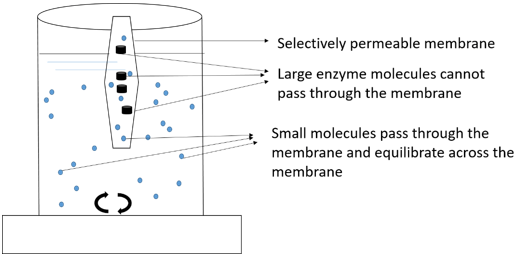This set of Enzyme Technology Multiple Choice Questions & Answers (MCQs) focuses on “Enzymes Purification – Dialysis”.
1. The process in which there is a free flow low molecular weight compounds across the membrane retaining high molecular weight compound is referred to as _____________
a) purity checking
b) dialysis
c) salting out
d) precipitation
View Answer
Explanation: Purity checking and precipitation are the steps involved in purification. Salting out is a phenomenon to precipitate the enzyme by reducing its solubility by reducing the available water content. Dialysis uses a membrane to allow free flow of low molecular weight compounds retaining the high molecular weight compounds inside.
2. Which of the following factors does not limit the rate of dialysis?
a) Dialysis membrane relative surface area
b) Retentate volume to diffusate volume
c) Type of substance
d) Diffusible substance concentration outside the membrane
View Answer
Explanation: The rate limiting factors for dialysis are as follows:
(i) Relative surface area of the membrane available for dialysis
(ii) The volume of the solution being dialyzed inside (retentate) to that of the solution outside (diffusate)
(iii) Concentration of diffusible substances outside the membrane.
The type of substance being dialyzed has no effect on rate of dialysis.
3. Which one of the following is not true for membrane selection?
a) Membrane should be highly polymerized thin films
b) Membrane should swell in presence of solvent
c) Volume of the solution being dialyzed by the membrane
d) Membrane should be chemically inert.
View Answer
Explanation: The one statement which is not true for membrane u volume of the solution being dialyzed by the membrane. As this one of the rate limiting factors for dialysis. Dialysis membranes should be in the form of thin films made up of highly polymerized materials, which swell in the presence of solvent allowing low molecular weight substances to pass while preventing high molecular weight substances. The membrane should be chemically inert and without fixed charged groups.
4. Pick odd one out.
a) Animal membrane
b) Polyethylene
c) Ammonium sulphate
d) Cellophane tubing
View Answer
Explanation: The odd one of the above is ammonium sulphate which is used to precipitate proteins. Whereas animal membrane, polyethylene and cellophane tubing are used as dialysis membrane which helps in removing ammonium sulphate. Collodion and colloids deposited in porous pot are also used as dialysis membrane.
5. The simplest way to remove ammonium sulphate from the system is _____________
a) precipitation
b) dialysis
c) chromatography
d) purity checking
View Answer
Explanation: Dialysis uses a cellophane tubing membrane which allows ammonium sulphate to enter and not the enzymes (proteins) which are high in molecular weight. Hence it is the simplest method. Precipitation, chromatography and purity checking are the steps involved in purification.
6. Which procedure is represented in the following diagram?

a) Ammonium sulphate fractionation
b) Ultrasonication
c) Ammonium sulphate removal by dialysis
d) Homogenization.
View Answer
Explanation: In the above diagram, enzyme solution has placed a bag of selectively permeable and this is immersed in a large volume of buffer which is stirred continuously. The procedure is carried out at 4 °C. This membrane allows small molecules ammonium and sulphate ions to pass into the buffer and equilibrate it. But this membrane does not allow the large weight molecular compounds like enzymes to pass through the membrane. Hence this diagram represents ammonium sulphate removal by dialysis. Ultrasonication and homogenization are used to extract enzyme from the cell by using physical forces. Ammonium sulphate fractionation is used to precipitate enzyme by using the salting out principle.
7. The volume of the solution which is being dialyzed is referred to as diffusate volume.
a) True
b) False
View Answer
Explanation: The volume of the solution which is being dialyzed is referred to as retentate volume and the solvent outside is referred to as diffusate volume. Retentate volume to diffusate volume is a rate limiting factor for dialysis. Hence the above statement is false.
8. What is retentate?
a) Solution is being dialyzed
b) Solvent outside
c) Small molecules
d) Membrane
View Answer
Explanation: In dialysis, the solution being dialyzed is referred to as retentate. As compared to diffusate which is solvent outside. The ratio of Retentate volume and diffusate volume is the rate limiting factor for dialysis. Membrane is a thin film through which dialysis occurs. Small molecules are those which pass through the dialysis membrane. Large molecules cannot pass through the membrane.
Sanfoundry Global Education & Learning Series – Enzyme Technology.
To practice all areas of Enzyme Technology, here is complete set of 1000+ Multiple Choice Questions and Answers.
If you find a mistake in question / option / answer, kindly take a screenshot and email to [email protected]
- Check Chemical Engineering Books
- Check Enzyme Technology Books
- Apply for Biotechnology Internship
- Apply for Chemical Engineering Internship
- Check Biotechnology Books
